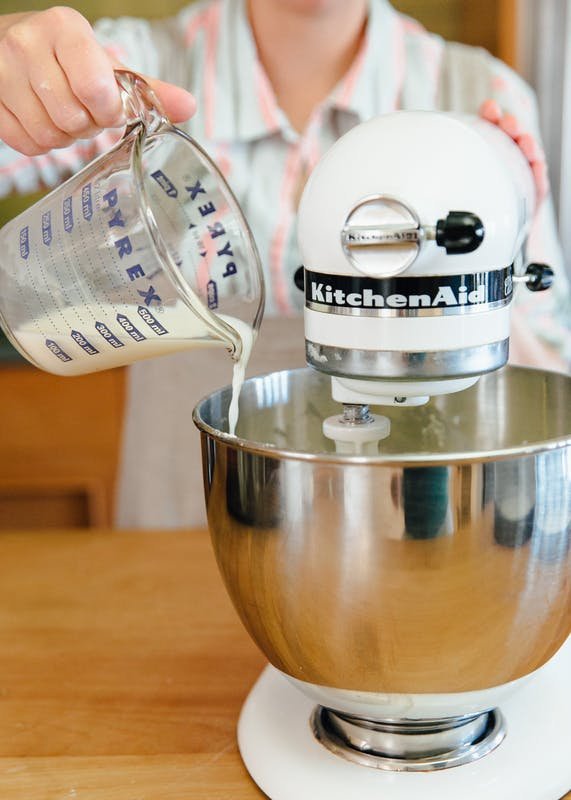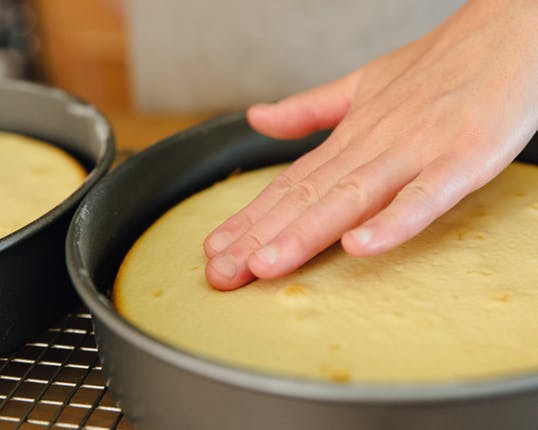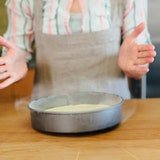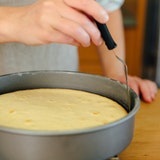How to bake a cake
 Creaming Butter and Sugar
Creaming Butter and Sugar
Want light, fluffy cakes with a tender crumb?
This first step is an important one that should not be overlooked. When mixing together softened butter and sugar, air is forced into the mixture to help aerate the batter and, when baked, assists in leavening the cake.
The paddle or blades of your mixer help incorporate air to lighten the butter. At the same time, the edges of the sugar granules cut into butter. This also makes for a more evenly mixed cake batter.
Creaming takes about three to five minutes at medium to medium-high speed. In the end, the mixture will be light, fluffy, and pale in color. Be sure to take your time here, because once you start adding in more ingredients, you cannot go back.
Although important, creaming butter and sugar really is not all that difficult or scary. If you are using a stand mixer, let it do the work for you.
If using a hand mixer, watch as the butter and sugar cream together to make beautiful ribbons of batter. It really can be quite pretty and fun. Just be sure to start with softened butter!
The Role of Eggs in a Cake
After the butter and sugar are creamed together, it is time to add the eggs. Add the eggs in one at a time to give them a chance to emulsify into the batter.
You may add the eggs while the mixer is running on low to further incorporate them. The eggs should be room temperature to create smoother, more homogenous batter — if the eggs are cold, the batter may appear curdled.
Alternating the Flour and Milk
Alternate adding the remaining dry ingredients with the wet. This way, the batter better absorbs all of the liquids without having to overmix the dry ingredients (more on this in a bit!).
To start, make sure your flour, baking powder, and salt are sifted together. With the mixer on low (you don't want flour flying everywhere), add in half the flour mixture.
Continue to mix until the last streaks of flour begin to disappear. With the mixer still running, stream in the milk. Now is a good time to add the vanilla extract, too. Once the milk is mostly absorbed, stop the mixer and scrape down the sides and bottom of the bowl.
 Turn the mixer back on to low speed, and add in the remaining dry ingredients. Once they begin to incorporate, bump up the mixer to medium.
Turn the mixer back on to low speed, and add in the remaining dry ingredients. Once they begin to incorporate, bump up the mixer to medium.
Only mix the batter together until it is smooth and the last visible bits of flour disappear. It is important not to overmix your batter or the cake may turn out dense, dry, and with "tunnels" running through the crumb. If you want some extra insurance, stop the mixer while there are still a few streaks of flour remaining and mix the rest of the way by hand with a rubber spatula.
This way also makes sure that no dry pockets are left at the bottom of the bowl.

Is It Done Baking?
Putting together a great cake batter is no simple task, so it's a good idea to know what to look for when checking to make sure your cake has baked properly. Instead of just relying on the clock, here are a few other indicators that your cake is done:
A cake is fully baked when a toothpick inserted into the center of the cake comes out clean, or with a few dry crumbs. If the toothpick appears wet with batter, then the cake is not done baking. Try baking for another few minutes before checking again.
When done, the surface of the cake should spring back after being gently pressed with a fingertip.
In some cases, the sides of the cake will start to pull away from the pan when done. Be careful, though — if the cake shrinks too much, then it might be on it's way to being overbaked
Once done, let your cakes cool on a wire rack. Wait for about 15 minutes, or until the cakes and pans are cool enough to handle, before removing the cakes from their pans. If you try to remove a cake that is too hot, it may break into pieces.
Let the cakes completely cool before trimming, cutting, or frosting. A chilled cake is much easier to cut and leaves less crumbs behind.
Heat the oven to 350°F. Gather your ingredients, then sift together the flour, baking powder, and salt. Set aside.
Heat the oven to 350°F.
Gather your ingredients, then sift together the flour, baking powder, and salt. Set aside.
Prepare the pans: Rub the bottoms and sides of the cake pans with a little butter, shortening, or baking spray. Make sure to get into the corners and all the way up the sides.
Flour the sides and bottoms of the pan by scooping a bit of flour into the pan, then shaking and tapping to coat the bottom and sides of the pan with flour.
Dump out the excess.
Alternatively, cut out a parchment round and use this to line the bottom.
Beat the butter and sugar until fluffy and light.
Beat the butter and sugar until fluffy and light. Cream together for about 3 to 5 minutes on medium spread (see above notes for more information).
Add the eggs one at a time. Beat until the batter is very smooth and creamy-looking. Adding the eggs one at a time gives them a better chance at incorporating into a smooth batter. Be sure that they are room temperature so that the batter does not appear curdled.
Beat until the batter is very smooth and creamy-looking.
Beat until the batter is very smooth and creamy-looking.
Beat in half the flour, salt, and baking powder.
Add the sifted dry ingredients with the mixer running at low speed. Continue to mix until incorporated.
Beat in the milk and vanilla. 
Alternate adding in the liquids with the dry ingredients so that the milk has a chance to be absorbed without needing to over-mix the batter. Stream in the milk with the mixer on low until combined.
Beat in the remaining flour mixture until just combined and no more visible flour remains. Scrape down the sides of the bowl as needed.
Stir a few times with a spatula to make sure no more flour remains on the bottom of the bowl.
Divide the batter between cake pans.
Use a scale or mechanical ice cream scoop to evenly divide the batter.
Smooth the tops with an offset spatula.
Drop the pans against the counter to shake out air bubbles.
Bake for 25 to 30 minutes.
When done, the cake should be puffed like a pillow, golden, and pull away from the sides of the pan.
A toothpick inserted into the center of the cakes should come out clean, when done.
When done, the cake should be puffed like a pillow, golden, and pull away from the sides of the pan.
A toothpick inserted into the center of the cakes should come out clean, when done.
Cool for 15 minutes in the pan.
Run an offset spatula round the cake to make sure it's completely loosened from the sides of the pan.
Flip the rounds out of the pan.
Flip the rounds out of the pan.
Remove the parchment lining.
Flip right side up to cool completely.
Flip right side up to cool completely.
Once cool, frost and assemble the cake with the buttercream.
How To Make a Basic Butter Cake from Scratch
Makes one 2-layer cake
What You Need
Ingredients
1/2 cup unsalted butter, softened (plus extra for greasing the pans)
1 1/2 cups sugar
3 large eggs
2 1/4 cups all-purpose flour
1 teaspoon salt
3 1/2 teaspoons baking powder
1 1/4 cups whole milk
1 teaspoon vanilla
2 1/2 cups buttercream frosting, such as basic buttercream
Equipment
2 9-inch round pans
Stand mixer or hand mixer
Measuring cups and spoons
Cookie scoop or measuring cup, for
dividing the batter
Instructions
Heat the oven to 350°F.
Sift together the flour, baking powder, and salt. Set aside.
Prepare the pans: Rub the bottoms and sides of the cake pans with a little butter, shortening, or baking spray. Make sure to get into the corners and all the way up the sides. Flour the sides and bottoms of the pan by scooping a bit of flour into the pan, then shaking and tapping to coat the bottom and sides of the pan with flour; dump out the excess.
Alternatively, cut out a parchment round and use this to line the bottom.
Beat the butter and sugar until fluffy and light. Cream together for about 3 to 5 minutes on medium spread (see above notes for more information).
Add the eggs one at a time. Beat until the batter is very smooth and creamy-looking. Adding the eggs one at a time gives them a better chance at incorporating into a smooth batter. Be sure they are room temperature so the batter does not appear curdled.
Beat in half the flour, salt, and baking powder. Add the sifted dry ingredients with the mixer running at low speed. Continue to mix until incorporated.
Beat in the milk and vanilla. Alternate adding in the liquids with the dry ingredients so the milk has a chance to be absorbed without needing to overmix the batter. Stream in the milk with the mixer on low until combined.
Beat in the remaining flour mixture until just combined and no more visible flour remains. Stir a few times with a spatula to make sure no more flour remains on the bottom of the bowl.
Divide the batter between cake pans. Use a scale or mechanical ice cream scoop to evenly divide the batter.
Smooth the tops with an offset spatula. Drop the pans against the counter to shake out air bubbles.
Bake for 25 to 30 minutes: When done, the cake should be puffed like a pillow, golden, and pull away from the sides of the pan. When done, a toothpick inserted into the center of the cakes should come out clean.
Cool for 15 minutes in the pan. Run an offset spatula around the cake to make sure it's completely loosened from the sides of the pan.
Flip the rounds out of the pan, remove the parchment lining, and flip right-side up to cool completely.
Once cool, frost and assemble the cake with the buttercream.
Recipe Notes
The baked cake rounds can be wrapped in plastic and kept frozen for up to 3 months.
Get buyer for it..